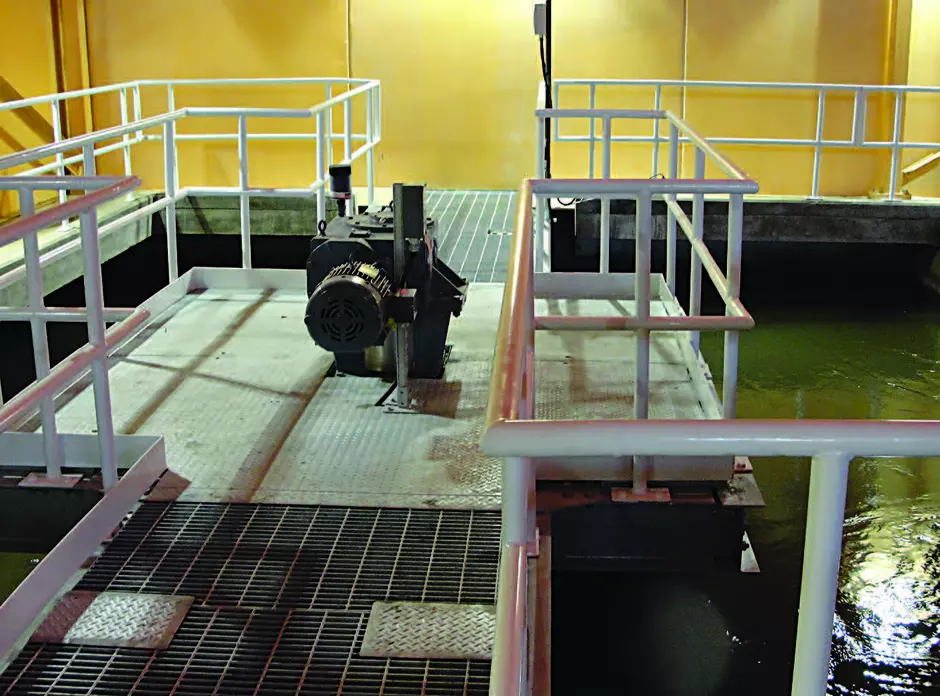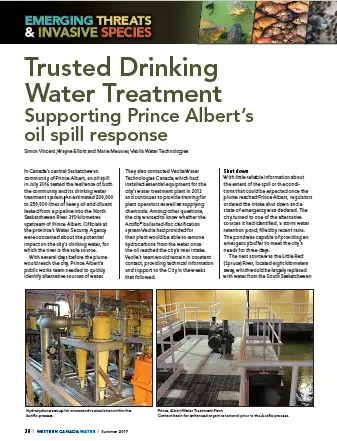Trusted Drinking Water Treatment Supporting Prince Albert’s Oil Spill Response
In Canada’s central Saskatchewan community of Prince Albert, an oil spill in July 2016 tested the resilience of both the community and its drinking water treatment system. An estimated 200,000 to 250,000 litres of heavy oil and diluent leaked from a pipeline into the North Saskatchewan River 390 kilometres upstream of Prince Albert. Officials at the province’s Water Security Agency were concerned about the potential impact on the city’s drinking water, for which the river is the sole source. With several days before the plume would reach the city, Prince Albert’s public works team needed to quickly identify alternative sources of water. They also contacted Veolia Water Technologies Canada, which had installed essential equipment for the city’s water treatment plant in 2012 and continues to provide training for plant operators as well as supplying chemicals. Among other questions, the city wanted to know whether the Actiflo® ballasted-floc clarification system Veolia had provided for their plant would be able to remove hydrocarbons from the water once the oil reached the city’s river intake.
Veolia’s team would remain in constant contact, providing technical information and support to the City in the weeks that followed.
Shut down
With little reliable information about the extent of the spill or the conditions that could be expected once the plume reached Prince Albert, regulators ordered the intake shut down and a state of emergency was declared. The city turned to one of the alternative sources it had identified, a storm water retention pond, filled by recent rains.
The pond was capable of providing an emergency buffer to meet the city’s needs for three days. The next source was the Little Red (Spruce) River, located eight kilometers away, which would be largely replaced with water from the South Saskatchewan River, once 30 kilometres of pipeline could be laid across varying elevations.
As water from the Little Red River was still needed during higher use periods, the water treatment plant team had to make constant adjustments to the equipment and chemistry to manage the continually changing raw water.
Over the nearly three months that the city would rely on alternative sources as efforts to clean up the oil spill on the North Saskatchewan River continued, the performance of the ballasted-floc clarification system was “the saving grace,” according to Andy Busse, manager of the Prince Albert water treatment plant. He said, “We never would have been able to treat the four separate sources without Actiflo®, which is a very robust and forgiving system. It’s the best technology I’ve seen in 20 years in water treatment.”
Testing the Waters
With winter approaching, the City of Prince Albert was concerned with the extent to which hydrocarbons were still present from heavier portions of the oil that had deposited into the river sediment upstream and whether these deposits could be treated if they became mobile?
Water and sediment samples from the river were laboratory tested in Veolia’s Montreal laboratory, with support from renowned water quality experts at Montreal’s Ecole Polytechnique, who also advised on potential health and environmental risks. In addition to testing hydrocarbon concentrations from different parts of the river, the city needed to be able to demonstrate what the ballasted-floc clarification system could handle in removing contaminated sediments and residual hydrocarbons.
In addition to the hydrocarbons, a key priority was the system’s ability to remove sediment, which poses the biggest risk of retransmission at the end of winter due to ice and higher water flows. “With the high turbidity and adsorptive properties, the system really seems to love removing hydrocarbons and especially sediments,” says Andy Busse. “It’s another shining light of the Actiflo® system.”

Prince Albert Water Treatment Plant Contact basin for enhanced organics removal prior to the Actiflo process.
Award Winning Outcome
In mid-September, regulators determined that raw water hydrocarbon measurements were low enough to allow the intake to be re-opened. To provide an extra measure of security, the city has implemented additional protective measures, including 24/7 online measurement capabilities. In October, the good quality of Prince Albert’s water was confirmed when it received the second-place award from the Western Canada Water Section of the American Water Works Association in an annual water taste test competition among municipalities in Saskatchewan, Manitoba and Alberta. “To be recognized as having some of the best drinking water in Western Canada is something very special that we are very proud of,” said Andy Busse.
More on Actiflo
Actiflo® technology uses a patented draft tube design to flocculate incoming solids with a proprietary micro-sand.
The dense micro-sand acts as a ballast as flocculation occurs, and dramatically increases the settling rate of the solids. This results in excellent solids/metals separation, using a very small footprint.
Hydro-cyclones separate the sludge from the micro-sand, and recycle it back into the unit, adding to the unit’s sustainable operation by minimizing sludge volume. With more than 1,000 references around the world, including a number operating in municipalities in Western Canada, this ballasted-floc clarification technology has been in use for municipal and industrial water and wastewater treatment for more than 20 years.
Originally published in Western Canada Water Magazine, Summer 2017.



